Update: December 15, 2024
Since writing this blog post, we have created several new rooms and puzzles. For many new ideas, please visit me at https://www.open-sesame.xyz/.
As with many people around the world at this time, our family has been pretty much stuck at home for social distancing. Recently our daughter had a suggestion to entertain ourselves: We could build escape rooms for each other. As typical with such a suggestion, I at first dismiss this as being too hard, and then get obsessed about it and do it anyway.
And so I spent about a week of my free time designing the story, puzzles, and materials. Obviously, I did not construct entire sets as is done for commercial escape rooms. But with some pretty simple and cheap equipment, I think we did a good job replicating the escape room experience.
So this blog is going to be part instruction and part bragging. There are already several sites available with lots of good advice for crafting home escape rooms. (I found Lock Paper Scissors to be particularly helpful.) This is just the overview of one room that we made. But perhaps you can find some good ideas here. Or just copy the whole thing if you like. You are welcome to it.
Equipment
Before jumping into the puzzles, let’s start with the preliminaries of what equipment you need. It turns out, you don’t need a lot of special items. Most of this stuff you probably have around the house.
Locks
The one exception is locks. Any interesting escape room is probably going to need 5 - 10 padlocks. Furthermore, you will probably want the type of locks where you can set your own code.
Fortunately, you’re not using them to really secure anything of value. The locks are more symbolic than anything else. So for less money than it would take to go to a “real” escape room, you can buy enough locks to build your own.
So here are some locks that I found useful.
Digit Locks

I found that it was easiest to make puzzles that make numbers, so most of the locks I used were number combination locks. We got a pack of these luggage digit padlocks. I found them easy to set and unambiguous when you dial in a code. As an added bonus, the dials have different colors, which you could work into the clues (although I didn’t take advantage of that).
Word Locks
To make things more interesting, it is fun to incorporate code words into the puzzles. For this, you need a padlock that uses letters instead of numbers.
There are multiple such locks available. We used a Master Lock word combination padlock, but I wasn’t particularly happy with it. The construction is solid enough for a puzzle (I’ve seen them used in commercial escape rooms many times), but the stupid thing doesn’t come with enough letter dials to actually form words. (It has 5 dials, but only comes with 4 dials with letters.) To make interesting words, you really have to buy two or more to mix and match dials.
Directional Locks
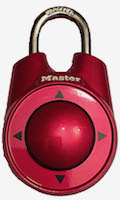
Master Lock sells a directional lock that has a knob on front that you push up/down/left/right to form a pattern. You can set it to your own combination of movement, but be careful because I managed to jam up (and hence destroy) one of these locks trying to set the pattern. A directional lock lends a nice change to the code representation, but it tends to be a little tricky to represent directions in a puzzle. I’ve never seen more than one used in any escape room.
Key Locks

You can also use locks that open with a key. You may find that you don’t use key locks as much as you would expect. A puzzle with a key usually requires building a physical apparatus, which can be pretty time consuming.
Paper Locks
Honestly, you don’t need physical locks. You could just put a note on a container or door that says do not open until you give the game master the correct code.
But there is something visceral about using a physical lock. The anticipation as the dials click and the cha-chunk when the lock finally opens. I think that adds enough value to justify using the physical locks.
Containers
Once you have your locks, the next thing you will need is stuff to lock up. Any escape room is going to make use of several containers (i.e. “boxes”) that hold items that provide clues to the next puzzle.
A commercial escape room builds most of these boxes into the room’s set. How elaborately you wish to match the boxes to your theme is up to you. You can buy or make special containers. Or you can just use containers like luggage, backpacks, and cases you have lying around your house, which is what I did.
Printer
I’ve never been to an escape room that did not have numerous notes, instructions, and labels. You can always hand-write these, but things will go much faster using a computer and printer.
Internet
Although not really practical for a commercial escape room, the internet is a handy resource to incorporate into a home escape room. Email and web are so integral in today’s life that putting part of the materials online is a fun and easy way to make puzzles more interesting. Just have the players bring in their smartphones to access puzzles and clues you put on the internet. Here are some free resources to set that up.
QR Codes
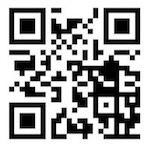
A QR code is the name for those square computer codes like that shown here. They are very convenient for taking a smartphone to a specific web site. With the most recent versions of iPhone and Android, you can just point the camera at the QR code, and you can tap right to the QR’s web page. QR codes are a convenient way to take players to an online clue or puzzle.
There exist many free QR code generators. Just search the web for them. The one I used was QR Stuff because it provides a service to shorten the URL to make more robust codes.
Online Documents
To incorporate the web into your puzzles, you will have to create online content. You don’t have to be an expert in web site design to create content. There are very simple ways to post something. A very simple way is to post a document online.
Google Docs is a convenient way to create an online document. Simply write the document in your browser, and then share it to get a URL to view it. Then use the aforementioned QR code generators to get players to that URL. Alternately, there are other file storage sites that allow you to share files such as Dropbox and OneDrive.
Web Site Builders
Simply posting a document might not look as nice as you would like. A page-based document won’t reformat itself for view on different mobile devices. A simple HTML-based web page might look nicer.
There are lots of ways to build web pages. Web page builders range from simple editors without a lot of control to complex. I used Google Sites, which is easy, but does not give you a lot of control.
Forms
Instead of writing a code into a lock, a puzzle can involve entering the correct response into a web form. Once again, rather than writing your own HTML code to create a form, you can use one of the numerous online form builders. I used Google Forms, which has a nice feature that allows you to “validate” responses that players have. Another nice feature is that you can embed a Google Form inside of a Google Site so you can mix form and other HTML elements.
Design
With the equipment out of the way, let’s talk about the design of the room. In my anecdotal knowledge, it is helpful to think about the room from three perspectives: the puzzles, the structure, and the story.
Puzzles
Obviously, a good escape room requires good puzzles. Maybe starting with the puzzles is a bit like putting the cart before the horse, but I found it useful to start by thinking about some of the puzzles I wanted to implement. Just keep in mind that each puzzle must end with the players progressing. That generally means that the puzzle ends in a lock combination or otherwise produces more information for the next puzzle.
This is not an organized list of puzzle ideas. I do list all of the puzzles that we used when describing our escape room. A quick Google search will provide multiple sites listing lots of good ideas.
Structure
After stripping away the details, an escape room can be characterized as a collection of “boxes” and “doors”. Each puzzle leads to the opening of a box or door. Boxes contain the items that are clues to the next puzzle. Doors (that are not the exit) open to new rooms filled with items and boxes. Once I started thinking about the escape room in terms of boxes and doors/rooms, the design became a lot easier.
You can think of an escape room’s structure as a flowchart leading from one box/room to the next. The opening of each box/room requires the solving of one or more puzzles. Each puzzle requires one or more items that, obviously, must be presented in an earlier box or room. Once you have the structure right, you can be sure that the escape room will flow correctly.
The above flowchart describes the escape room I made. Even though there were over 30 independent items/clues to organize, they all fell into this simple structure.
If you take a look at the outline of my escape room, you will see that it is broken down in this manner. Although playing the room looked like a haphazard collection of items, the structure of boxes/doors ensured that at any time the players had everything they needed (and usually a little more).
Story
Finally, a good escape room needs a story to bring it all together. Sure, you could just fill a room with a bunch of puzzles to solve. But to make the experience really satisfactory, there should be a compelling story that the players experience as they move from one solution to the next. Players are rewarded not just by getting more puzzles, but by advancing their story forward. So getting the story right is just as important as anything else.
Some advice I read was to start with the story first and move to the puzzles afterword. Although I agree that having a good story structure early is important, it is also important to be flexible in the design. I found it very helpful to move back and forth among the story, structure, and puzzles to make sure they all fit together. Sometimes the story drove the puzzles. Sometimes the structure changed the story.
Our Room
Now that we’re done with all the general things about designing escape rooms, let’s go over the actual story we did in our home. Since the puzzles and story are interrelated, I’ll describe the escape room as the progression of boxes and rooms. For each one, I’ll describe the puzzles used to unlock that section.
For anyone interested in recreating some or all of this escape room, I will also provide, where possible, the materials I used. (A collection of escape room material is available in this Google Drive folder.) I will go into some details about the puzzles to help recreate them. Since this is a focus group of one, I will also discuss what did and didn’t work.
The Scenario
In the scenario for the escape room, the players are researchers at a microbiology and infectious diseases laboratory. The lead researcher of the lab, Dr. Sarah Beaker, has been away in the field researching COVID-19 and attempting to find a cure. (At the time of this writing, COVID-19 is the main issue of the world. You can replace with another real or fictitious disease if you like.)
Today at work, the players are presented with a package sent from Dr. Beaker. It contains a note in which she is requesting help from the players. To start, Dr. Beaker is stranded without communication. The players need to reestablish this communication.
Reestablishing Email
Using information from Dr. Beaker’s letter, the players reestablish communication. Once they do this, they receive an email from Dr. Beaker with further instructions to find a formula for virus treatment and break into her private lab.
The Puzzle
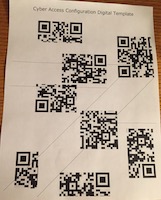
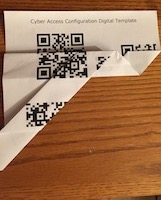
The starting packet comes with this piece of paper with several fragments of QR codes. None of them alone will work.
The trick is that the paper must be folded in just the right way to form a complete QR code. Once the paper is properly folded, the players can use their phones to scan the code, which takes them to the email from Dr. Beaker.
How Well it Worked
The players (my wife and two daughters, all of which have played in several escape rooms) caught on right away that the paper needed to be folded to create a whole QR code. However, when I made this puzzle, I did not appreciate the many ways the paper could be folded other than the Mad fold-in style I was thinking of. Thus, if I were to use this puzzle again, I would simplify it in at least a couple ways.
First, I went way overboard with adding extra QR fragments to make the real folds less noticeable. They worked too well, and made the puzzle rather frustrating. I would probably remove any QR fragment that did not contribute to the final, usable code. Instead, I would leave the remainder blank or put some images that are clearly not QR codes.
Second, I put in some dotted lines to guide where the folds should be. However, I should have also put in some guides on where the folds should line up. The problem is that the place where the valley fold is can’t be seen while being folded, so the players kept trying to use the valley fold line to line up the edge of the previous mountain fold. Anyway, the point is that those old Mad fold-ins had three lines to guide the folds, and I should have included all three.
Overall, the puzzle worked, but it probably would have been more satisfying if I hadn’t made it so hard.
Getting the Formula
Per Dr. Beaker’s email, the players need to find the formula for treatment. Because the email is not secure, Dr. Beaker cannot overtly say how to get the formula. But the email contains a hidden code that is used to open box 1, revealing some of Dr. Beaker’s lab notes containing the formula (and multiple other items used later).
The Puzzle
A careful reading of the email reveals some oddly specific details. In particular, the email uses the words “three,” “one,” and “sixteen” rather unnecessarily. These are the only numbers that appear in the email. These numbers form the code to the lock on the box: 3116.
How Well it Worked
Hiding a code in a note in this way is a pretty standard escape room puzzle, and the seasoned players caught on once they realized the numbers were there. However, spelling out the numbers maybe hid them too well. It took some prompting of rereading the email aloud to catch all the numbers. In retrospect, it might be better to use digits for the numbers (i.e. “3,” “1,” and “16”) instead of spelling out the words.
Finding the Doctor’s Stash
Dr. Beaker has hiding a secret stash of “oregano.” She has also misplaced some critical items that the players need with this stash, so they will have to find it. In addition to these items, the players find a small baggie of oregano (which has no practical value).
The Puzzle
Sitting on a table when the players enter the first room is a crossword puzzle. The players have to solve the crossword (which is not meant to be hard). The crossword has the following answers:
- Blood
- Skeleton
- Heart
- Deathly
- Freeze
- Doorknob
- Order
- Fire
Here is where things get tricky. Of these 8 words, only 4 of them matter: blood, deathly, order, and fire. The real trick is realizing that these 4 words are contained in the last 4 books in the Harry Potter series: Goblet of Fire, Order of the Phoenix, Half Blood Prince, Deathly Hallows. I knew all the players were very familiar with Harry Potter, and the series of books was sitting in the bookshelf in the room.
Taking these 4 words in the order that they appear in the Harry Potter series, you can form a code from the crossword answer number. So Fire:8, Order:7, Blood:1, Deathly:4 yields the code 8714. This code opened the box containing the doctor’s stash.
How Well it Worked
As I expected, the leap from the 8 words in the puzzle to the Harry Potter series was very difficult. I tried to add a clue to the crossword by giving it the title “Puzzle Magic,” but it was lost on the players. So, it would have been helpful to have a stronger hint to the books, or pick something else in the room more noticeable.
Entering Dr. Beaker’s Lab
According to Dr. Beaker’s email, the players need to break into Dr. Beaker’s Lab. The formula found by the players leads to a secret word that is used to open the word lock on the door to the lab.
The Puzzle
The formula in Dr. Beaker’s lab notes lists the following elements in order:
- Vanadium
- Indium
- Carbon
- Iodine
- Cobalt
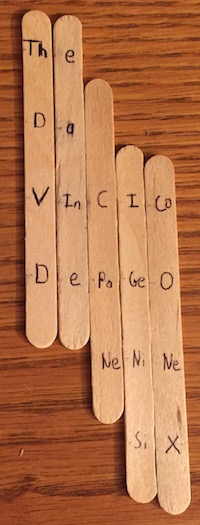
Also distributed in previous containers are 5 popsicle sticks with element symbols written on them. The players convert the elements in the formula to element symbols (V, In, C, I, Co) using a provided periodic table for reference. Each of these elements appears exactly once in the popsicle sticks with one on each stick. The players need to line up the elements on the sticks as shown in this picture.
With the popsicle sticks in this arrangement, the letters should be written out from left to right, top to bottom. It spells out the words “The Da Vinci Code page one nine six.”
The book The Da Vinci Code was planted in the bookshelf. On page 196 was a note with the (sort-of) word “SICKY”. This is the code to use on the lock to the next room.
How Well it Worked
This is a tough puzzle but the players managed to work it out. The players went through several stages of different ways to solve this. But the players managed to work their way forward progressing in steps: noticing that each stick had one element, ordering the sticks, arranging the sticks on the table horizontally, and finally figuring their vertical positions. The hardest part was figuring out that the sticks were not meant to be lined up horizontally, but they figured it out.
Overall, this was a challenging but solvable and rewarding puzzle. However, solving this puzzle requires some experience. The puzzle should probably be simplified for beginners.
A Mutation
On entering the lab, the players need to open a container that contains (among multiple other clues) a note from Dr. Beaker warning that the disease seems to be mutating into something more sinister. This sinister information motivates the players to continue to establish a secure connection to get more information.
The Puzzle
This box actually had two locks on it, each with its own puzzle.
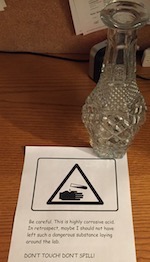
The first puzzle involves a beaker sitting in the lab. A note next to the beaker describes the substance the beaker contains as corrosive acid. (It’s really just water.)
Also inside the beaker is a key. The players can’t touch the liquid (and the opening is too small to stick a hand in. Instead, the players have to use a magnet tied to the end of a string, which was provided in an earlier box, to fish the key out of the beaker. The key, of course, opens one of the locks.
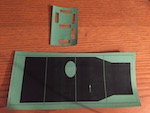




The second puzzle involves a digit decoder and a digit template shown here. When the decoder is placed on top of the template in the proper places, the black parts of the template show through some of the holes in the decoder, revealing a digit. The final code is 3594.
How Well it Worked
The beaker puzzle was a gimme. The time it took the players to solve this was just as long as it took to run back and grab the magnet-on-a-string. But nevertheless the players enjoyed it a lot. In retrospect, it would be good to seed the room with more easy puzzles like this for more gratification of moving forward.
It took the players a few minutes to figure out how the digit template worked, but they figured it out on their own pretty quickly. This was a good puzzle that was fun: not too obvious, but not too challenging.
Zombies!
Using a note about increasing security, the players access Dr. Beaker’s login page. Unfortunately, the players do not know the right password (and never will), but find a way around the security anyway. Once they circumvent the security, the players receive a secure note from Dr. Beaker that informs the players that the disease is in fact turning victims into zombies!
The note instructs the players to collect supplies to battle the zombies and provides the players with a code for a briefcase in the room, which contains clues for the last two puzzles.
The Puzzle
Unlocking these clues required the players to solve several steps. First, players had to scan a QR code that was on the bottom of the note about increasing security to take them to the login page.
The login page invites the players to find a password to get into the system. The trick is that no password exists. Instead, the players have to notice that there is a link at the bottom of the login page labeled “Reset Password”.
Clicking this takes the players to a secondary reset password form. Instead of a password, the reset password form requires the users to answer the following 3 security questions:
- What are your favorite FOODS?
- What MONTH were you born?
- What is the name of your CHILD?
The players don’t directly know the answers to these questions, but there is a clue to help them figure it out.

Throughout the game the players have been collecting styrofoam cups with letters written around the rims. At this point in the game, the players have collected 5 such cups. When stacked together, the cups form a cryptex. The players need to stack the cups in the right order and twist the cups so that the highlighted words in the security questions, FOODS, MONTH, and CHILD, are spelled on the cups. The remaining letters form the words of the answers to the security questions: CANDY, MARCH, and JOHNY.
Once the players enter these words in the reset password form, they are taken immediately to the secure note from Dr. Beaker. At the bottom of the note the code to the next box is provided. (I figured the players worked hard enough to get to this point.)
How Well it Worked
This was a tricky sequence of puzzles, but the players did a good job working through them. They were also able to tell when they made progress.
On the initial login page page, the players spent some time trying to figure out what the password was supposed to be (as I anticipated they would). But eventually one of them noticed the reset password link, and it became pretty clear that was what needed solving.
The players were also able to discern what the cups were for pretty quickly. In retrospect, I wish I had picked words with more unique letters. There were several letters common to multiple words, which made it difficult to determine the order of the cups and also the arrangement. Nevertheless, the players were able to determine the correct arrangement.
Survival Kit
The players now needed to unlock the zombie survival kit. The kit comprises a pair of (Nerf) guns and ammo. The kit also contains the final clues to the exit door including a final note from Dr. Beaker.
The Puzzle
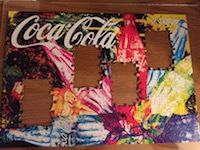
When the players entered the lab (second room), there was a partially completed jigsaw puzzle. Missing in the puzzle were 4 open sections.
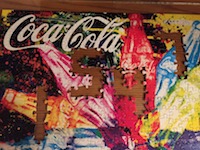
Provided in previous boxes were packs of jigsaw puzzle pieces, which fit within this puzzle. When the players add all the provided puzzle pieces, it reveals a code: 1547.
How Well it Worked
I think the puzzle was a pretty good idea. However, I really underestimated the time it would take the players to complete the puzzle. Toward the end of the game there was a long pause as all the players had to work to complete the puzzle.
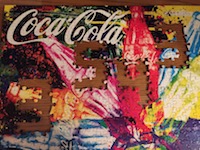
In fact, I had this clever little feature built in so that before the players receive the last packet of jigsaw puzzle pieces, the puzzle spells out the wrong code (as listed here). Unfortunately, the players never saw this because they were still working on the puzzle when they got the last of the puzzle pieces. So, in retrospect I would have done things a little different.
First, I would have been more careful about the colors of pieces I removed from the puzzle. Pieces from multiple regions were mostly black, which made it more difficult to determine what part of the puzzle they should go in. I should have picked regions with more distinct colors to allow the players to figure out where the pieces went faster.
Second, I did not provide the puzzle start until the second room. However, I should have put the puzzle in the first room and started to provide puzzle pieces early. This would give the players time to complete the puzzle and also give players something to do while others worked on other puzzles.
Join Up with Dr. Beaker
Dr. Beaker’s final note requests the players to meet up with her by following the path she previously took. Using cards of cities provided in previous boxes, the players have to determine the order in which Dr. Beaker visited these cities and use a provided map to trace the path she took. The directions of this path on a provided map provide the combination on the directional lock covering the escape room’s exit.
The Puzzle

As props for this puzzle, I repurposed pieces from the Pandemic board game (appropriately enough). Throughout the game players were provided with city cards from this game. The last of the 6 cards were placed in the last box that could be opened. Also provided in the lab (second room) was the game board for the game, which features a map of the world with cities that match those on the cards.
The final note contains the hint that Dr. Beaker traveled from the most populated to least populated cities. The Pandemic city cards print the population of the city, so this provides the order in which the cities should be “traversed.” The cards given in the order of the populations were as follows:
- New York
- Beijing
- Istanbul
- Kinshasa
- Bogota
- Montreal
When tracing a direct line between these cities on the provided map, the directions traveled are roughly right, left, down, left, and up. These are the directions used on the directional lock.
How Well it Worked
I thought this puzzle would be difficult, but in fact the players got it right away. One of the players was familiar with the board game, so she knew right away that the population is printed on the cards. Also, they picked up on the clue of tracing a path on the map and had no trouble translating that to the directional lock (which at this point in the game was the only lock left).
Attack!
Once out of the final door, the players must fight their way past zombies. Using their zombie survival equipment (Nerf guns), the players shoot attacking zombies (pictures of zombies that I taped to the wall outside the room).
The Puzzle
No puzzle here. This is just a fun activity that rewards the players for escaping the room.
How Well it Worked
I added this part of the game as an afterthought. I figured if I was going to use Nerf guns as a prop, there should be something to shoot at.
This turned out to work great. The players attacked the paper zombies with gusto, and Nerf bullets were flying all over the place. This was a really fun end to the game.
It occurs to me that more escape rooms should have a mini activity like this at the exit as a little reward for completing it. It makes for a very satisfying end to the game.
License
As I stated before, I am providing the full collection of escape room material that I generated for anyone who wants to use part or all in their own activities. If you are just using this at home, that is probably all you care about. But if you want to use these materials in a more public way, you may care about a license.
So, this material is licensed under a Creative Commons Attribution 4.0 International License. That means you can reuse, modify, and redistribute this material however you see fit (even for commercial purposes). I do not ask for any money. Just a little credit.
Of course, this license only extends to the original material provided in this post. It does not extend to other trademarks and copyrighted material included (but perhaps not limited to) Master Lock, Nerf, the Pandemic game, the books referenced, the jigsaw puzzle image, and the clip art used.

